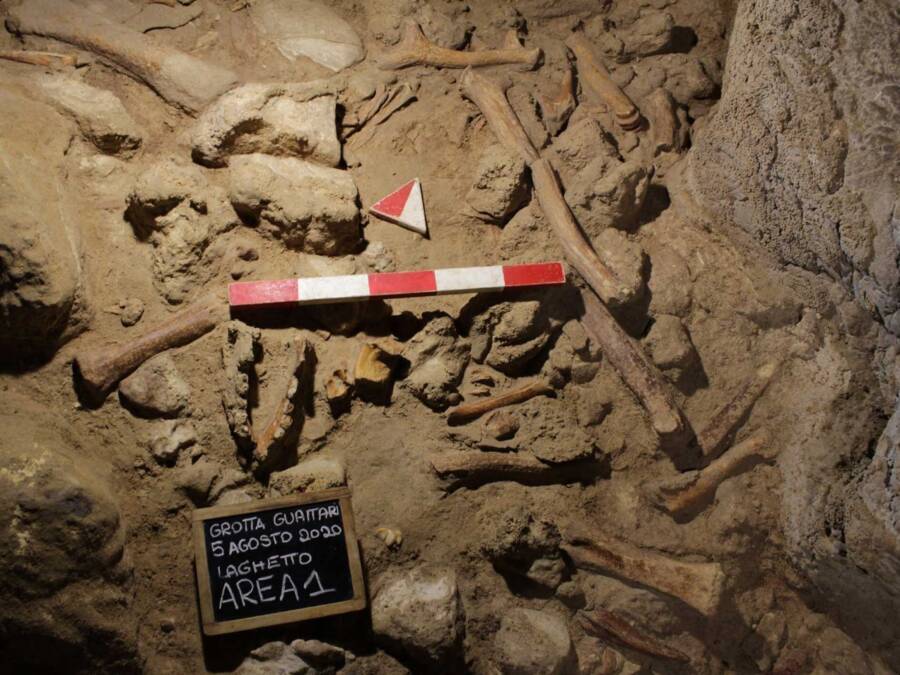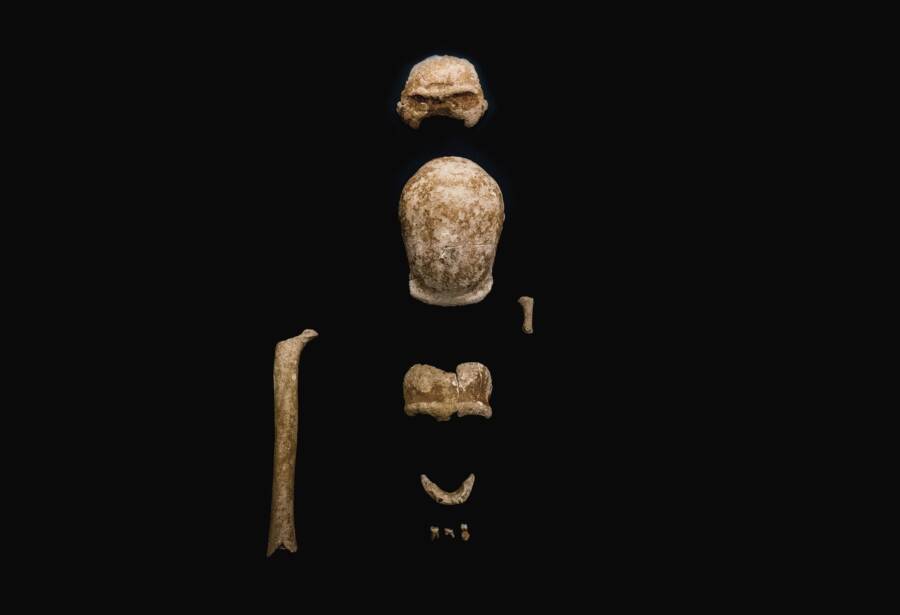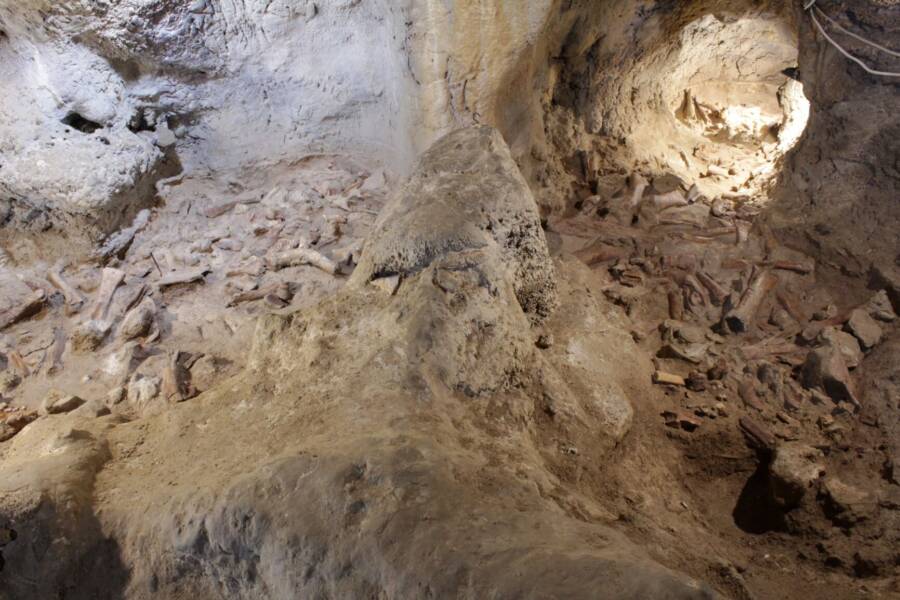When the first Neanderthal skull was discovered with a hole carved in it, paleontologists thought it was a sign of ritual cannibalism — but now know hyenas were the predators.

Italian Ministry of CultureMany of the bones showed signs of being burnt and featured cut marks or clear signs of gnawing.
In 1939, workers at a beachfront hotel to the south of Rome accidentally discovered the mutilated skull of a Neanderthal in a long-sealed cave underneath the property.
At the time, the prevailing theory held that cavemen used the site for ritual cannibalism — and regularly feasted on the brains of the dead. But newly uncovered evidence now suggests hyenas were the culprits all along.
Experts uncovered the fossilized remains of nine more Neanderthals at Guattari Cave in a find made public on Saturday, according to The New York Times. These coastal town excavations at the San Felice Circeo site yielded male and female victims of all ages and the remains of several long extinct wild animal species.
The historic site proved to be an invaluable treasure trove of relics, from the bones of ancient hyenas and elephants to those of rhinoceroses and Aurochs — an extinct ancestor of modern-day domestic cattle. According to Mauro Rubini, chief anthropologist of the local Culture Ministry, it’s clear the find will have enormous ramifications.
“The story of the cave didn’t finish in 1939 and still had a lot to give,” he said. “Consider that the human skeleton is a formidable archive that tells us everything: their age, sex, height, what they ate, their genome, whether they had illnesses, how much they walked and even if they were able to have fun.”

Italian Ministry of CultureThe remains of 11 individuals have been found in Guattari Cave since 1939, one of the largest and rarest clusters of Neanderthal bones ever discovered.
Neanderthals are long extinct, with experts generally agreeing that they vanished from the gene pool about 40,000 years ago. In 1939, finding ancient remains of this Homo sapien cousin at the foot of a seaside hotel left experts with guesswork. DNA testing was still decades in the future.
Fortunately, technological advancements and 80 years of studying our Stone Age ancestors have allowed researchers to already begin interpreting the significance of the skulls and bones. For Mario Rolfo, an archaeology professor at Tor Vergata University, it’s now clear this group of ancients lived in fear of predators — specifically hyenas.
“Neanderthals were prey for these animals,” he told the BBC. “Hyenas hunted them, especially the most vulnerable, like sick or elderly individuals.”
Rolfo currently believes that a pack of ruthless Stone Age hyenas tore these Neanderthals to shreds before dragging them back to their cave, which likely served as a kind of storeroom. One of the nine victims was a young boy, and another a woman. Eight of the remains are between 50,000 and 68,000 years old, while the ninth could be as old as 100,000 years.

Italian Ministry of CultureThe oldest fossilized remains discovered in Guattari Cave are possibly 100,000 years old.
Paleontologist Alberto Carlo Blanc was the first to posit that the original two skulls discovered in 1939 had been cannibalized by fellow Neanderthals. A sizable hole in one skull had him convinced that this individual had his brains extracted for nourishment. This latest research, which began in October 2019, yielded animal gnawings on the bones.
“Reality is more banal,” said Rolfo, adding that “hyenas like munching on bones. What it does mean is that there were many Neanderthals in the area.”
Italian Culture Minister Dario Franceschini said it was “an extraordinary discovery which the whole world will be talking about.”
Fortunately for people like Franceschini, Guattari Cave has been closed off for thousands of years. An ancient earthquake or potential landslide had blocked easy access inside and left its contents protected for 50,000 years. That first find in 1939 was historic, and it yielded the oldest Neanderthal skull ever found.
Paleontologists studied the cave for 10 to 15 years before excavations ceased in the early 1950s. For the last 20 months, however, diligent research has taken experts into areas of the cave that have never been entered before, yielding bones with cut marks, burned bones, and the realization that hyenas were in play.

TwitterHotel Neanderthal is currently for sale.
“Together with two others found in the past on the site, they bring the total number of individuals present in the Guatarri Cave to 11, confirming it as one of the most significant sites in the world for the history of Neanderthal man,” said the Culture Ministry according to France 24.
San Felice Circeo Mayor Giuseppe Schiboni has applied for funding from the European Union to bolster the archaeological appeal of his jurisdiction. He has already expressed interest in opening a European center on the study of Neanderthals in the area, with virtual reality experiences for curious visitors.
Angelo Guattari hopes that the cave will one day open for tourism. His father owned the Guattari Hotel in 1939 and saw the first skull discovered in the cave named for his family with his own eyes. Meanwhile, the scenic beachfront hotel has been renamed “Hotel Neanderthal” and is currently up for sale.
For Rubini, Neanderthals are certainly deserving of rigorous study as they “were the uncontested lords of Eurasia for about 250,000 years.”
He plans to pull as much data and information out of those bones as humanly possible: “We are working on solid scientific data so we can give a complete picture of the situation.”
After reading about the Neanderthal remains found in Italy’s Guattari Cave, learn about the earliest evidence of modern humans in Europe. Then, read about Neanderthals taking antibiotics as early as 50,000 years ago.





